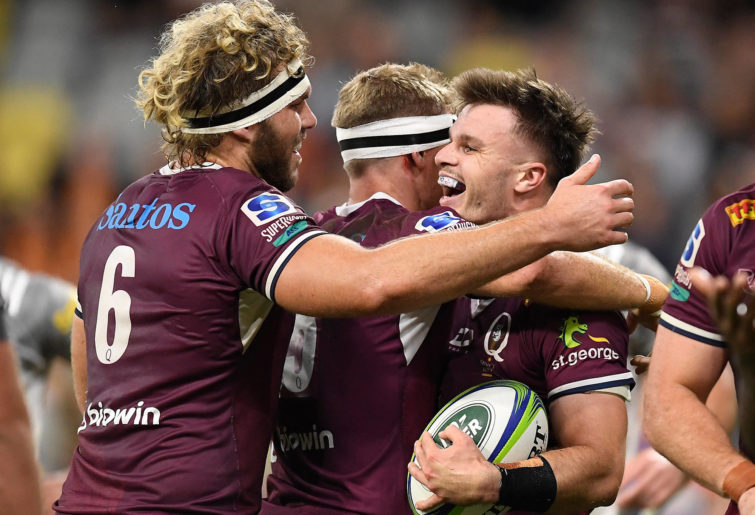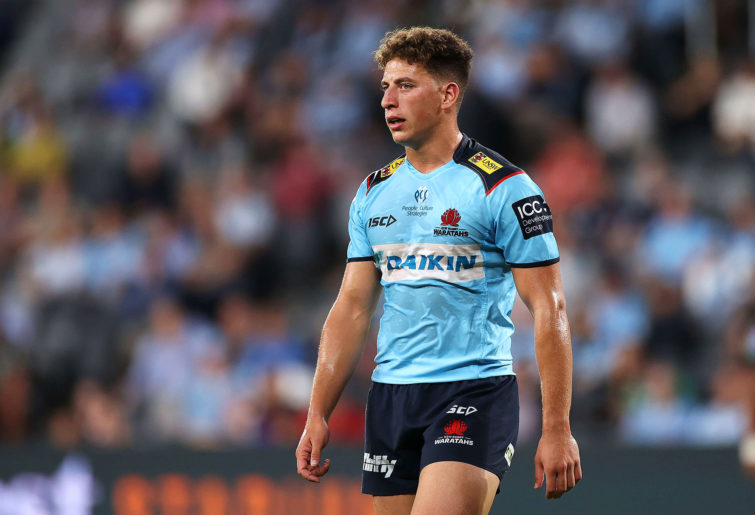It was like watching a different beast completely.
Sitting pitch-side in Canberra on Saturday night, it was fascinating to see a Brumbies side so comprehensively outplayed in the contest in the two games prior suddenly dictating terms, not unlike the way they ripped into the first seven rounds of Super Rugby in 2020 before the competition – and the world, pretty much – was put on hold as the pandemic took hold.
After leaving nothing in the tank to fall agonisingly short against the Crusaders in Christchurch to kick off their three-week tour of New Zealand, the Brumbies were disappointingly bullied out of the contest against both the Chiefs and the Blues.
They didn’t measure up physically – by their own words, standards, and admissions – which allowed the Chiefs and Blues to dominate proceedings and control all aspects of plays. The second half against the Blues read 21-0, and “selection disappointment” resulted, as Dan McKellar put it.
The reaction against the Hurricanes was exactly as hoped, and the relief on Brumbies’ faces was very clear after they secured the 12-10 win right on the bell. And after losing however many games it’s been this year in the final play or with the final kick of the game, it was nice to have some luck finally turn their way.
But if it’s true that you make your own luck, then the Brumbies did plenty to create theirs on the night.
The game opened at a frantic pace, but slowed as the home side started controlling the breakdown speed. The back-row battle was fascinating in itself, with both teams happy to push the envelope as far as the could get away with; a level reached once the Hurricanes lost Du’Plessis Kirifi to a yellow card midway in the first half, during which neither team added a point.
As the Brumbies gained the lead in the second half, they continued to play both direct and in the wider channels, crucially making sure the Hurricanes’ defenders were always engaged. For a match so evenly scored across the stats sheet and the scoreboard itself, it’s interesting to note how many more tackles the Hurricanes forwards made.

(Photo by Mark Kolbe/Getty Images)
The Brumbies upped their desire to carry in traffic, with Rob Valetini, Henry Stowers and Lachlan Lonergan surprisingly leading the way. I say surprisingly for Lonergan, because it was noticeable how often he found offloaded ball and good second-phase metres. He and brother Ryan aren’t twins, but there was a twin-like connection with the number of times the siblings found each other.
In the face of stiff defence, the Brumbies carried strongly, made regular gain-line incursions, and pressured the Hurricanes into mistakes and infringements. Essentially, everything the Chiefs and Blues did to them the fortnight previous.
And while this was great to see, it was of course a few weeks too late.
The importance of this point being that a few weeks too late in such a short competition like Super Rugby Trans-Tasman is the difference between contending and playing for pride. The Brumbies’ inability to back up their performance against the Crusaders hurt them dearly, and now the best they can hope for is to finish the season strongly at home and play spoiler for the ambitions of the Highlanders.
Sadly, this is the common story among the Australian sides.
With no wins recorded by the end of Round 2, three wins was never going to be enough to finish in the top two. As it stands heading into the final round, four wins likely won’t be enough either.
Just as the Brumbies did on Saturday night, the other Australian sides have improved significantly as the competition got on, all of them showing elements to their game that have improved hugely since the end of the Australian competition, too.

(Photo by Ian Hitchcock/Getty Images)
The Western Force, for instance, are playing wider again and actually looking to play toward their best finishers again, something they did well across the final rounds of Super Rugby AU, too. They worked the centre corridors really well – Fergus Lee-Warner and Ollie Callan were impressive – and then identified where the space was and played to that.
The score is the score, and none of this changes that. But it’s a sign that the Force do know – or at least have remembered how – to play to the attacking strengths that have developed this year. It’s a good sign, almost a shame we’re rapidly running out of time to see more of it.
The same applies to the Melbourne Rebels’ scrum as well, which seem to find a switch that’s been buried for most of 2021, and just suddenly started dominating the Chiefs’ pack before halftime on Sunday.
I’m sure I wasn’t alone at 19-0 after 25 minutes thinking that the Chiefs were about to do a Black Caps on England at Lord’s. Next thing you know, Isi Naisarani is steering five blokes in front of him and with the ball at his feet to obliterate the Chiefs’ scrum with a pushover try.
That seemed to spark their generally misfiring attack, and Naisarani was making metres for fun with the ball as the Rebels cancelled out the Chiefs’ lead completely at the break.
That they couldn’t go on with it is another issue, and I still wonder if the approach of interim coach Kevin Foote is going to be different enough for the Rebels to play more dynamically and more threateningly than they have for the last few seasons. But this, too, was a good sign.
The Waratahs’ defence remains an issue; we all know that. They’ve conceded nine, eight, seven, and ten tries over the four games of Trans-Tasman. That’s ten more than the next worst defending team in the comp.
But in scoring 15 tries across the series, they’ve now equalled the same number of tries they scored across eight games in Super Rugby AU. Jack Maddocks’ try was well worked, and Mark Nawaqanitawase’s try was exactly the sort of counterattacking try Australian teams have been on the receiving end of over the ditch for years. Good signs.

(Photo by Cameron Spencer/Getty Images)
It was good to see Queensland playing a lot more directly against the Blues in the Primary Colours Cup, after being guilty of playing too laterally of late.
Much of that was out of necessity. The late withdrawal of Bryce Hegarty on top of James O’Connor being ruled out of what would’ve been his 100th game forced Hamish Stewart to return to flyhalf for the first time in a long time. But playing a largely distributing role, Stewart played into the strengths of Isaac Henry and Hunter Paisami in midfield, while Mac Grealy on debut and Filipo Daugunu got in on the action as well. Harry Wilson had perhaps his best ball-carrying game of the series as well.
The Reds played a lot more in the face of the Blues and the game swung accordingly. It will be interesting to see how or if the Reds can reproduce this against the Hurricanes, or if they can follow the Brumbies’ lead in controlling the breakdown contest the same way.
They’ve shown they can dictate terms in the collision this year, so why not?
And this is why all the Australian coaches are united in their belief that a full Trans-Tasman competition in 2022 will bring more benefit than the domestic plus cross-over format of this year.
Playing better opposition consistently, rather than just in a block after the full home-and-away domestic competition, is where the required incremental improvements will come.
Of course, they all know that what is needed from a rugby sense might not match what broadcasters would prefer, too. But it is possible to have both. You could play a domestic sprint series after Trans-Tasman, for example.
In the end, how it’s sliced doesn’t really matter. The improvements we’ve seen over the round and more should convince people that more Trans-Tasman competition – and not less – is what’s required.































































































